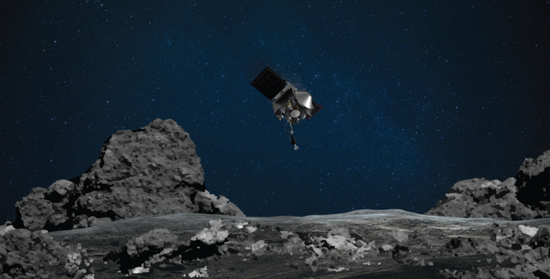
Photo provided by NASA on Oct. 20, 2020 shows Origins, Spectral Interpretation, Resource Identification, Security-Regolith Explorer (OSIRIS-REx) mission readies itself to touch the surface of asteroid Bennu. (Xinhua)
NASA said its Origins, Spectral Interpretation, Resource Identification, Security-Regolith Explorer (OSIRIS-REx) mission touched down on asteroid Bennu on Tuesday and collected a sample from the asteroid's surface.
It is the first U.S. mission to retrieve a pristine sample of an asteroid and return it to Earth for further study.
The van-size spacecraft briefly touched down its arm in a landing site on Bennu called Nightingale. Later, the spacecraft completed a back-away burn, and moved to a safe distance away from Bennu, according to NASA live broadcast.
"Sample collection is complete," NASA tweeted. After a Touch-And-Go maneuver to capture a sample, the spacecraft fired its thrusters to back away from Bennu's surface and navigate to a safe distance away, said NASA.
Preliminary data show the sample collection event went as planned, said the mission team, adding more details are expected once all the data from the event are downlinked to Earth.
The spacecraft performed the entire sequence of approaching the asteroid and collecting the sample autonomously, which lasted about 4.5 hours.
The spacecraft fired a pressurized nitrogen bottle into the asteroid, using the gas as a way to lift material off Bennu's surface.
The spacecraft's collector head, located on its robotic sampling arm, captured the stirred up material. This head is the only part of the spacecraft that touched Bennu.
The sample is scheduled to be returned to Earth in September 2023.
"Congratulations to the entire @OSIRISREx team and all of @NASA's partners on this mission! We are on the way to returning the largest sample brought home from space since Apollo. If all goes well, this sample will be studied by scientists for generations to come!" NASA Administrator Jim Bridenstine tweeted.
Located more than 200 million miles from Earth, Bennu is a boulder-studded asteroid shaped like a spinning top and as tall as the Empire State Building in New York City.
The asteroid contains material from the early solar system and may contain the molecular precursors to life and Earth's oceans, according to NASA.
Bennu could potentially threaten Earth late in the next century, with a 1-in-2,700 chance of impacting Earth during one of its close approaches, said NASA.
The samples from Bennu could help scientists understand not only more about asteroids that could impact Earth but also about how planets formed and life began.
OSIRIS-REx was launched on Sept. 8, 2016 and arrived at Bennu on Dec. 3, 2018.
Since arriving at Bennu, the spacecraft and its cameras have been collecting and sending back data and images to help the team learn more about the asteroid's composition and map the best potential landing sites to collect samples.
"Bennu is almost a Rosetta Stone out there, and it tells the history of our Earth and solar system during the last billions of years," said Thomas Zurbuchen, associate administrator of NASA's Science Mission Directorate.
